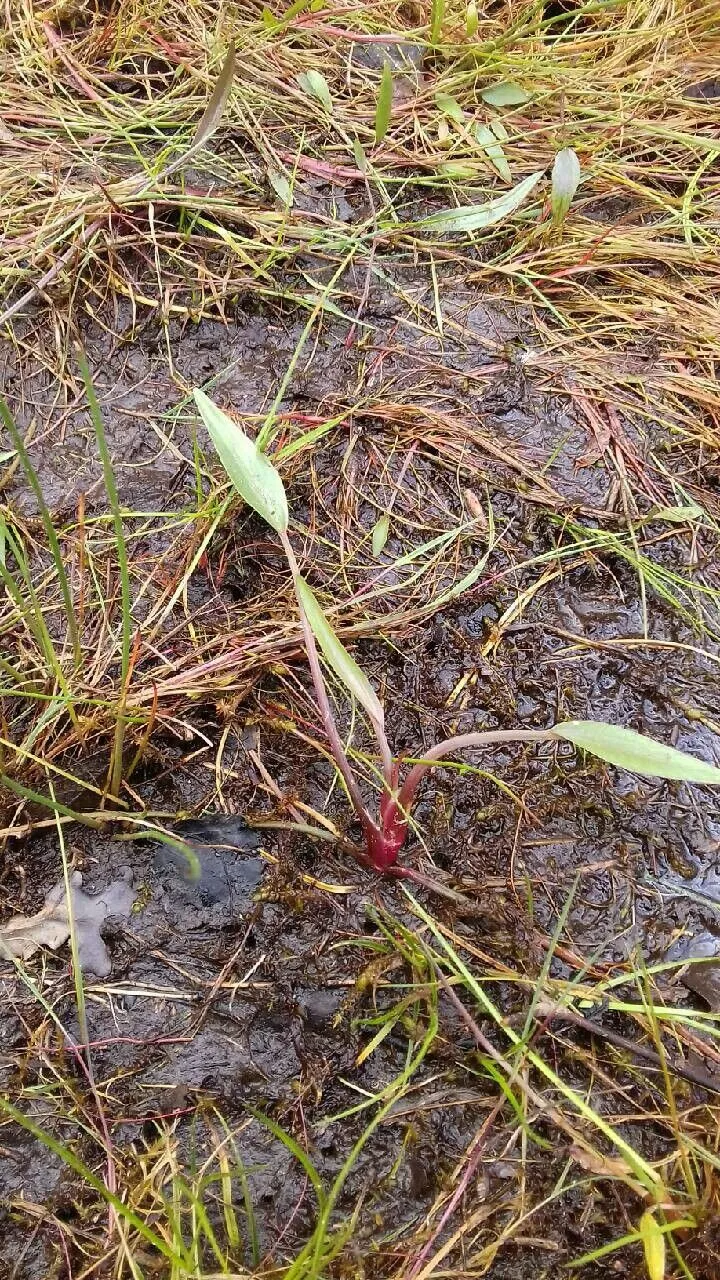
Author: With.
Bibliography: Bot. Arr. Brit. Pl. ed. 3, 2: 362 (1796)
Year: 1796
Status: accepted
Rank: species
Genus: Alisma
Vegetable: False
Observations: Macaronesia, NW. Africa, Europe to China
Narrow-leaf water-plantain, scientifically known as Alisma lanceolatum, is an intriguing aquatic plant that belongs to the Alismataceae family. This species has garnered attention for its distinctive linear leaves and preference for wetland habitats.
Described in 1796 by With., Alisma lanceolatum has a broad geographic range, being found in regions such as Macaronesia, northwestern Africa, and extending across Europe to China. This distribution highlights the plant’s adaptability to various aquatic environments across these regions.
Characteristic of its common name, the narrow-leaf water-plantain possesses elongated, lance-shaped leaves that are distinctly narrower compared to other species within the genus Alisma. These leaves typically grow in clusters, emerging from the plant’s basal rosette, which supports its slender, erect flowering stems.
The inflorescence of Alisma lanceolatum comprises numerous small, delicate flowers, which are often white or pale pink. These blooms are arranged in a branching panicle that rises above the water surface, making the plant not only functional within its ecosystem but also visually appealing.
Narrow-leaf water-plantain thrives in freshwater habitats such as ponds, marshes, and the edges of slow-moving water bodies. Its ability to anchor itself in these aquatic settings with its strong, fibrous root system helps stabilize the soil and provides habitat for various aquatic organisms.
Ecologically, Alisma lanceolatum plays a significant role in its native habitats. It participates in nutrient cycling and offers shelter and food for a range of wildlife. These attributes make it an essential component of the wetland ecosystems where it naturally occurs.
In summary, the narrow-leaf water-plantain (Alisma lanceolatum) is a remarkable aquatic plant notable for its narrow, lance-shaped leaves and its wide distribution from Macaronesia and northwestern Africa to Europe and China. It continues to interest botanists and ecologists alike, contributing both to its natural habitat and the aesthetic beauty of the regions it inhabits.
Eng: lanceleaf water plantain, narrow-leaf water-plantain, narrow-leaved water-plantain, lance-leaved water-plantain, narrow water-plantain
Dan: lancet-skeblad, smalbladet skeblad
Deu: lanzettblättriger froschlöffel
Swe: gotlandssvalting, lancettbladig svalting
Fra: plantain deau lancéolé, alisma lancéolé, alisma lancéolée, flûteau lancéolé, flûteau à feuilles lancéolées,, plantain d’eau à feuilles lancéolées
Nld: slanke waterweegbree
Lav: šaurlapu cirvene
Nno: gotlandsvassgro
Nob: gotlandsvassgro
Spa: alisma lanceolada
Cym: dwfr llyriad culddail, dŵr-lyriad culddail, llyriad-y-dŵr culddail
En: Narrow-leaf water-plantain, Lanceleaf water plantain, Narrow-leaved Water-plantain, Lance-Leaf Water-Plantain, Lance-leaved water-plantain, Narrow Water-Plantain, Lanceleaf Water-plantain
Be: Шальнік ланцэтны
Bg: Ланцетолистна лаваница
Ca: Alisma lanceolat
Zh: 膜果泽泻
Hr: Suličasti žabočun
Cs: Žabník kopinatý
Da: Lancet-skeblad, Smalbladet skeblad
Nl: Slanke waterweegbree
Et: Süstlehine konnarohi
Fi: Suikeasarpio
Fr: Alisma Lancéolée, Plantain deau lancéolé, Alisma lancéolé, Flûteau lancéolé, Flûteau à feuilles lancéolées,, Plantain d’eau à feuilles lancéolées, Flûteau à feuilles lancéolées
De: Lanzett-Froschlöffel, Lanzettblättriger Froschlöffel
He: כף-צפרדע אזמלנית
It: Mestolaccia lanceolata, Mestolaccio lanceolato
Lv: Šaurlapu cirvene
Lt: Lancetinis dumblialaiškis
Nb: Gotlandsvassgro
Nn: Gotlandsvassgro
Pl: Żabieniec lancetowaty
Pt: Orelha-de-mula-lanceolada
Ru: Частуха ланцетная
Es: Llanten de agua, Alisma Lanceolada
Sv: Gotlandssvalting, Lancettbladig svalting
Zh-hant: 膜果澤瀉
Cy: Llyriad-y-dŵr culddail, Dwfr Llyriad Culddail, Dŵr-Lyriad Culddail
© copyright of the Board of Trustees of the Royal Botanic Gardens, Kew.
© copyright of the Board of Trustees of the Royal Botanic Gardens, Kew.
© copyright of the Board of Trustees of the Royal Botanic Gardens, Kew.
Taken May 14, 2016 by Tela Botanica − Liliane ROUBAUDI (cc-by-sa)
Taken Jul 3, 2016 by Tela Botanica − Paul FABRE (cc-by-sa)
Taken Jul 8, 2016 by Tela Botanica − Jean-Paul COROLEUR (cc-by-sa)
Taken May 14, 2016 by Tela Botanica − Liliane ROUBAUDI (cc-by-sa)
Taken May 2, 2022 by Tristan Jaton-Maria (cc-by-sa)
Taken Jul 23, 2022 by stéphane COLLE (cc-by-sa)
Taken Aug 10, 2017 by Yoan MARTIN (cc-by-sa)
Taken May 2, 2022 by Tristan Jaton-Maria (cc-by-sa)
Taken May 14, 2016 by Tela Botanica − Liliane ROUBAUDI (cc-by-sa)
Taken May 14, 2016 by Tela Botanica − Liliane ROUBAUDI (cc-by-sa)
Taken Aug 10, 2017 by Yoan MARTIN (cc-by-sa)
Taken Aug 21, 2022 by Richard Thomas (cc-by-sa)
Taken May 2, 2022 by Tristan Jaton-Maria (cc-by-sa)
Taken Aug 10, 2017 by Yoan MARTIN (cc-by-sa)
Taken Aug 10, 2017 by Yoan MARTIN (cc-by-sa)
Taken Aug 10, 2017 by Yoan MARTIN (cc-by-sa)
Taken Jun 4, 2013 by Tela Botanica − Geneviève Botti (cc-by-sa)
Taken Jun 4, 2013 by Tela Botanica − Geneviève Botti (cc-by-sa)
Taken Aug 8, 2019 by Mindert de Vries (cc-by-sa)
Taken Jul 29, 2022 by Alain Deflesselles (cc-by-sa)
Taken May 27, 2009 by Tela Botanica − Sylvain PIRY (cc-by-sa)
Taken Jun 3, 2018 by Tela Botanica − Pat DESNOS (cc-by-sa)
Taken May 14, 2016 by Tela Botanica − Liliane ROUBAUDI (cc-by-sa)
Taken Jul 30, 2011 by Tela Botanica − Bertrand BUI (cc-by-sa)
Ph maximum: 7.5
Ph minimum: 7.0
Light: 7
Atmospheric humidity: 8
Bloom months: [‘may’, ‘jun’, ‘jul’, ‘aug’, ‘sep’]
Soil nutriments: 5
Family: Myrtaceae Author: (F.Muell.) K.D.Hill & L.A.S.Johnson Bibliography: Telopea 6: 402 (1995) Year: 1995 Status:…
Family: Rubiaceae Author: Pierre ex A.Froehner Bibliography: Notizbl. Bot. Gart. Berlin-Dahlem 1: 237 (1897) Year:…
Family: Sapindaceae Author: Koidz. Bibliography: J. Coll. Sci. Imp. Univ. Tokyo 32(1): 38 (1911) Year:…
Family: Asteraceae Author: A.Gray Bibliography: Pacif. Railr. Rep.: 107 (1857) Year: 1857 Status: accepted Rank:…
Family: Fabaceae Author: Medik. Bibliography: Vorles. Churpfälz. Phys.-Ökon. Ges. 2: 398 (1787) Year: 1787 Status:…
Family: Aspleniaceae Author: (Cav.) Alston Bibliography: Bull. Misc. Inform. Kew 1932: 309 (1932) Year: 1932…